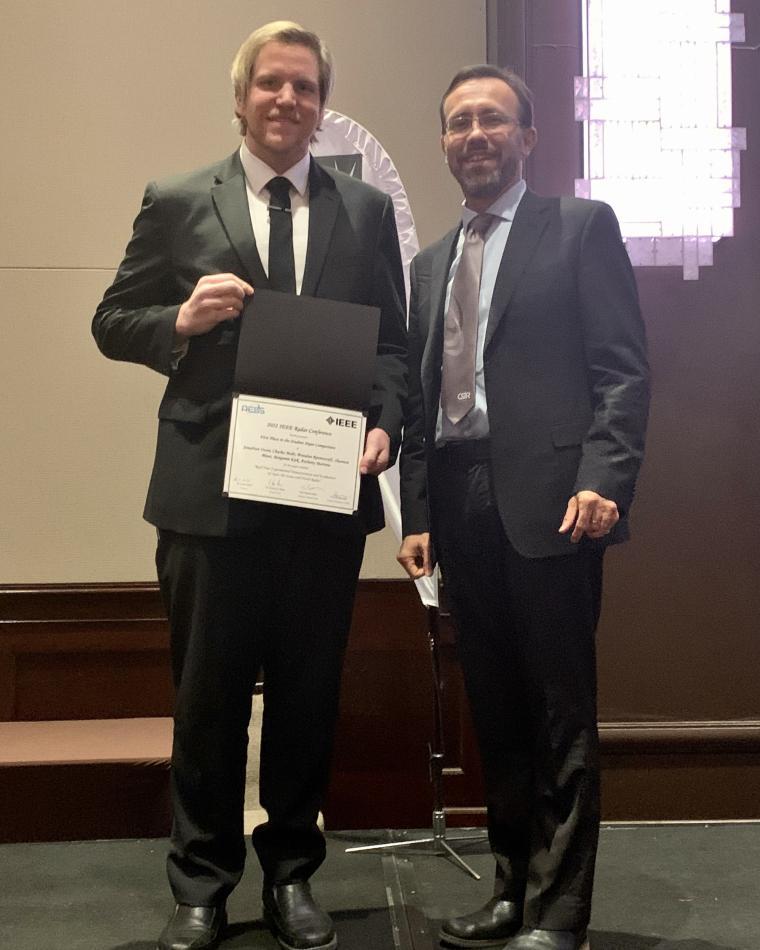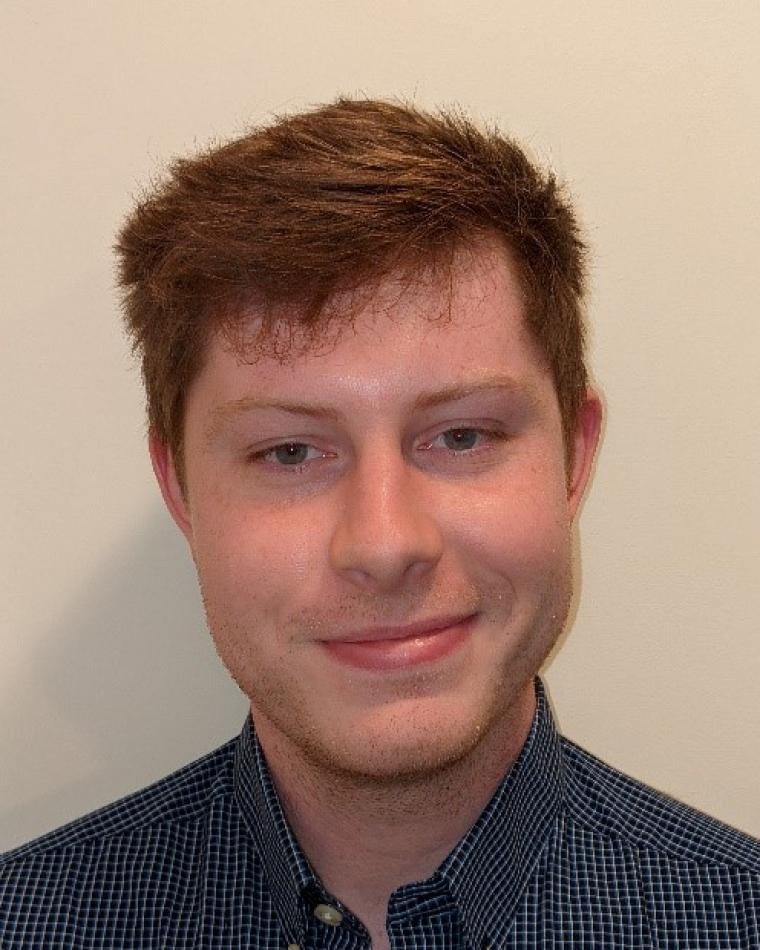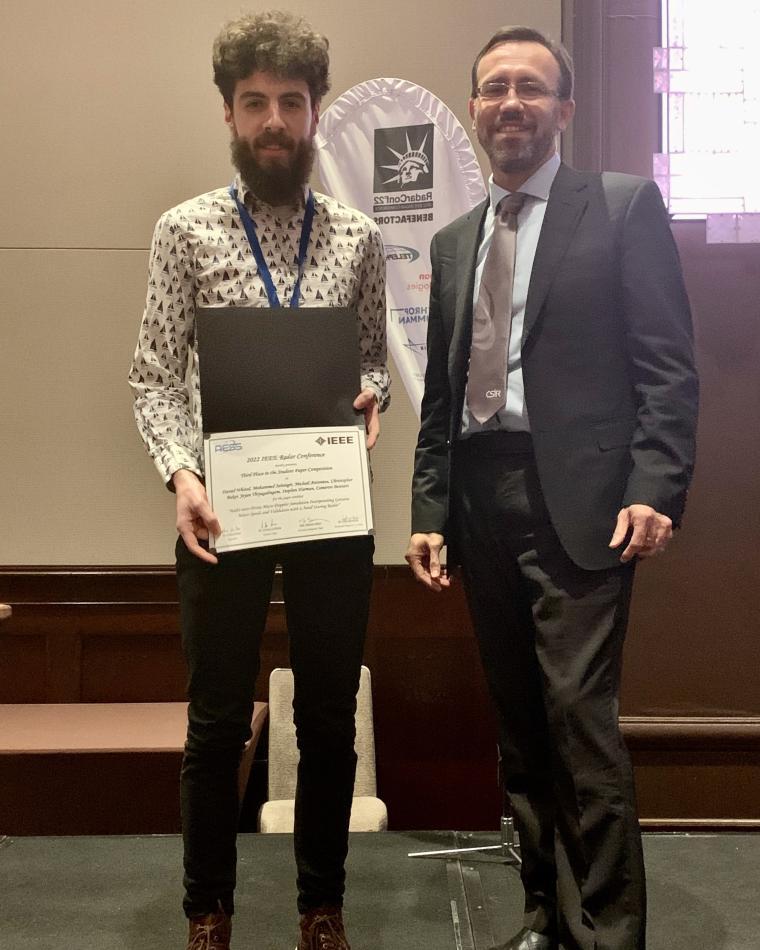The Story Behind a Success
As the winners of the Student Paper Competition at the 2022 IEEE Radar Conference, we are honored to share this success story with the AESS community. We’d like the thank the organizing committees for the conference and student paper competition. Volunteers commit their time to contribute to the radar community by forming an independent judge panel, reading through dozens of papers annually to promote future generations of radar engineers.

1st place: Jonathan Owen - “Real-Time Experimental Demonstration and Evaluation of Open-Air Sense-and-Notch Radar"
I am honored to be selected for a top student paper award at the 2022 IEEE Radar Conference. I am a Ph.D. student at the University of Kansas (KU) researching cognitive radar, waveform diversity, and real-time processing using nontraditional algorithms. As the RF spectrum becomes increasingly congested due to 5G communications and the Internet of Things, demand has proportionately risen for radar operations that mitigate mutual interference between other users. Arbitrary waveform generation has expanded the breadth of radar operation through greater design degrees of freedom, such that spectral notches can be incorporated into the signal frequency spectrum. In this paper, a sense-and-notch software-defined radar operating in real-time in an open-air setting is evaluated while performing moving target indication (MTI) processing in the presence of a dynamically hopping interferer. This implementation is shown to support pulse repetition frequencies up to 4.4 kHz, meaning new interference-responsive waveforms can be produced at that rate while achieving a transmit notch depth of 25 dB relative to peak power (greater depth is possible with additional computational resources). I hope to further contribute to the real-time implementation of nontraditional algorithms and exploration of cognitive radar paradigms.
This success would not have been possible without the support of the Army Research Laboratory (ARL) and KU Radar Systems Laboratory (RSL) staff members. Their insight has significantly influenced the track of my professional career and I am fortunate to have acquired a diverse skillset by interacting in such creative research environments.

2nd place: Christian C. Jones, paper 4208 “Development & Experimental Assessment of Robust Direction Finding and Self-Calibration”
Attending and presenting at the 2022 IEEE Radar Conference was an amazing opportunity. Not only was I able to present my work in person, but I was also able to interact with so many incredible radar scientists and engineers. So, I am beyond honored to be selected as one of the top student papers at the 2022 IEEE Radar Conference. I am a Ph.D. student at the University of Kansas (KU) where my research emphasis is radar signal processing and waveform diversity in the context of exploring the capabilities of modern hardware. My paper explored an iterative framework for the direction of arrival estimation and array calibration using signals of opportunity. The support of KU and the Army Research Laboratory allowed us to perform open-air experimental validation using a variety of test setups.
I was fortunate to have the support of the Naval Research Laboratory, Army Research Laboratory, and Radar Systems Lab (RSL) at KU. I am grateful for their aid, which has given me countless opportunities to develop both as a person and as an engineer.

3rd place: Daniel Whited - Multi-rotor Drone Micro-Doppler Simulation Incorporating Genuine Motor Speeds and Validation with L-band Staring Radar
I was honored to have my work recognized as one of the top student papers of the conference. The paper was my first ever published work and it was a joy and pleasure to attend and present in New York, with the paper competition on top of this altogether forming a wonderful experience. I am a Ph.D. student at the University of Birmingham (UoB) in the UK and submitted the paper a year after starting the postgraduate course following an undergraduate in Physics at the same university. The UK Government's Department for Transport (DfT) Future Aviation Security Solutions (FASS) program has funded a host of PhDs to assess and improve the contemporary security challenges of air travel; mine was the robust detection of drone presence with radar. The contribution of this paper was to create the most true-to-life synthetic drone I/Q data yet, which was enabled by incorporating real motor speed recordings into a standard simulation model. This approach simulates a rotary-winged drone's microDoppler with very close likeliness to real radar signatures. I am very excited to see this method applied by others across different radar bands and in the creation of synthetic drone data for classification applications.
Thanks to the UK Government DfT for funding my project. The work would not be possible without the UK National Quantum Hub in Sensing and Timing with their support and infrastructure. Thanks also to Aveillant Ltd for engaging in my work and the greater work at UoB. Finally, thanks to the many individuals: my supervisors, Dr. Mohammed Jahangir and Dr. Mike Antoniou, and the many others in the Microwave Integrated Systems Laboratory (MISL) group at UoB.
